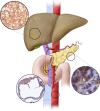Obstructive Sleep Apnea, Hypoxia, and Nonalcoholic Fatty Liver Disease
- PMID: 30422676
- PMCID: PMC6835083
- DOI: 10.1164/rccm.201806-1109TR
Obstructive Sleep Apnea, Hypoxia, and Nonalcoholic Fatty Liver Disease
Abstract
Recent studies have demonstrated that obstructive sleep apnea (OSA) is associated with the development and evolution of nonalcoholic fatty liver disease (NAFLD), independent of obesity or other shared risk factors. Like OSA, NAFLD is a prevalent disorder associated with major adverse health outcomes: Patients with NAFLD may develop cirrhosis, liver failure, and hepatocellular carcinoma. One major finding that has emerged from these studies is that the OSA-NAFLD association is related to the degree of nocturnal hypoxemia in OSA. Animal models have therefore largely focused on intermittent hypoxia, a key manifestation of OSA, to shed light on the mechanisms by which OSA may give rise to the complex metabolic disturbances that are seen in NAFLD. Intermittent hypoxia leads to tissue hypoxia and can result in oxidative stress, mitochondrial dysfunction, inflammation, and overactivation of the sympathetic nervous system, among many other maladaptive effects. In such models, intermittent hypoxia has been shown to cause insulin resistance, dysfunction of key steps in hepatic lipid metabolism, atherosclerosis, and hepatic steatosis and fibrosis, each of which is pertinent to the development and/or progression of NAFLD. However, many intriguing questions remain unanswered: Principally, how aggressively should the clinician screen for NAFLD in patients with OSA, and vice versa? In this review, we attempt to apply the best evidence from animal and human studies to highlight the relationship between these two disorders and to advocate for further trials aimed at defining these relationships more precisely.
Keywords: dyslipidemia; insulin resistance; intermittent hypoxia; metabolic syndrome; sleep disordered breathing.
Figures

References
-
- Tasali E, Ip MS. Obstructive sleep apnea and metabolic syndrome: alterations in glucose metabolism and inflammation. Proc Am Thorac Soc. 2008;5:207–217. - PubMed
-
- Aron-Wisnewsky J, Clement K, Pépin JL. Nonalcoholic fatty liver disease and obstructive sleep apnea. Metabolism. 2016;65:1124–1135. - PubMed
-
- Loomba R, Sanyal AJ. The global NAFLD epidemic. Nat Rev Gastroenterol Hepatol. 2013;10:686–690. - PubMed

